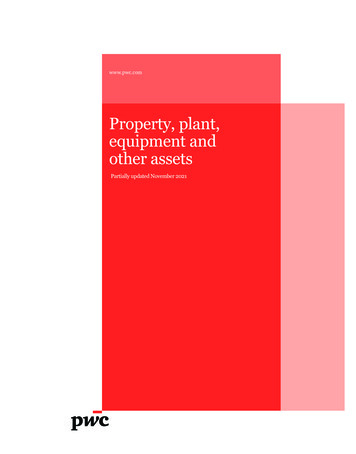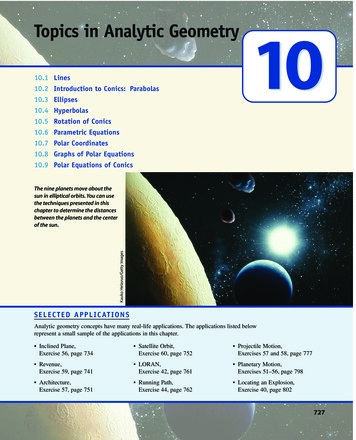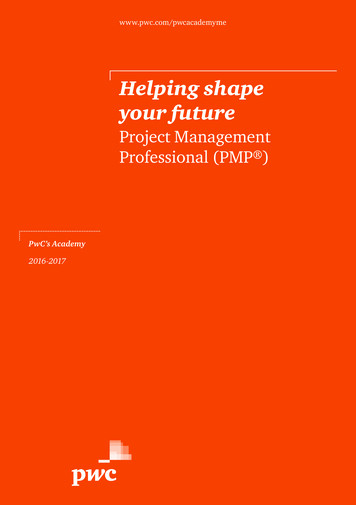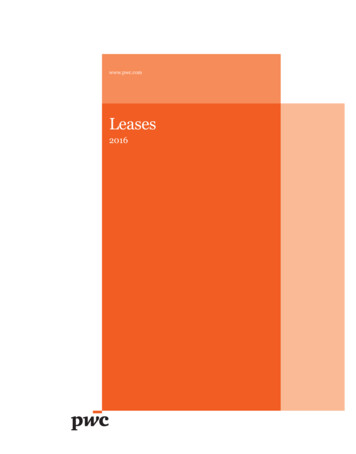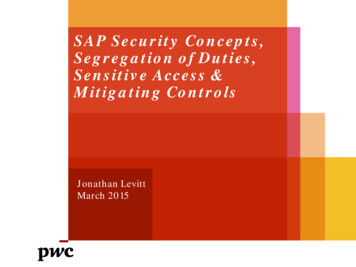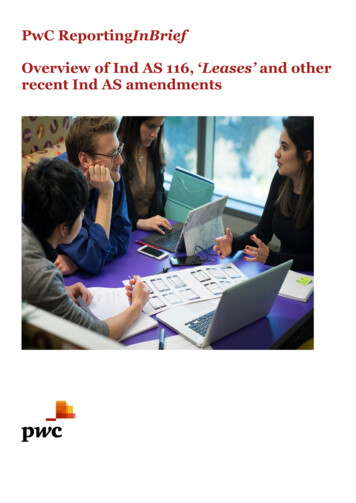
Transcription
PwC ReportingInBriefOverview of Ind AS 116, ‘Leases’ and otherrecent Ind AS amendments
In briefThe Ministry of Corporate Affairs (MCA) notified Ind AS 116, the new leases accounting standard, and certain other amendmentsto Indian Accounting Standards (Ind AS) on 30 March 2019. Ind AS 116 and other amendments come into force on 1 April 2019.This publication gives an overview of the impact of changes, which may be significant for some entities, helping companiesunderstand if they will be affected and to begin their considerations. It will help entities plan more effectively by highlightingwhere new processes and systems or more guidance may be needed.Ind AS reporters are required to disclose information relevant to assessing the impact of Ind AS 116 and other amendments inperiods prior to adoption. For instance, entities will have to provide expected impact of these changes in their financial statementsfor the year ended 31 March 2019. This publication sets out our practical suggestions of matters to consider while preparing thedisclosures in respect of these recent amendments.Let's talkParagraphs 30 and 31 of Ind AS 8, ‘Accounting Policies, Changes in Accounting Estimates and Errors’, detail the disclosurerequirements for the expected impact of new accounting standards which have not yet been adopted. In particular, Ind AS 8requires entities to disclose known or reasonably estimable information relevant to assessing the possible impact that applicationof Ind AS 116 and other Ind AS amendments will have on an entity’s financial statements in the period of initial application. Incomplying with these requirements, an entity considers disclosing:a)b)c)d)e)the title of the new Ind AS;the nature of the impending change or changes in accounting policy;the date by which application of the Ind AS is required;the date as at which it plans to apply the Ind AS initially; andeither:(i)a discussion of the impact that initial application of the Ind AS is expected to have on the entity's financialstatements; or(ii)if that impact is not known or reasonably estimable, a statement to that effect.It is therefore important that entities carefully consider the expected impact of Ind AS 116 and other Ind AS amendments, toprovide specific and meaningful disclosures.In detailOverview of Ind AS 116Ind AS 116 will replace the current guidance in Ind AS 17, ‘Leases’. Ind AS 116 defines a lease as a contract, or part of a contract,that conveys the right to use an asset (the underlying asset) for a period of time in exchange for consideration.Under Ind AS 116 lessees have to recognise a lease liability reflecting future lease payments and a ‘right-of-use asset’ for almost alllease contracts. This is a significant change compared to Ind AS 17, under which lessees were required to make a distinctionbetween a finance lease (on balance sheet) and an operating lease (off balance sheet). Ind AS 116 gives lessees optional exemptionsfor certain short-term leases and leases of low-value assets.In the statement of profit and loss lessees will have to present interest expense on the lease liability and depreciation on the rightof-use asset. In the cash flow statement, cash payments for the principal portion of the lease liability and its related interest areclassified within financing activities. Payments for short-term leases, leases of low-value assets and variable lease payments notincluded in the measurement of the lease liability are presented within operating activities.The accounting by lessors will not significantly change. As under Ind AS 17, the lessor will continue to classify leases as eitherfinance or operating, depending on whether substantially all of the risks and rewards incidental to ownership of the underlyingasset have been transferred. For a finance lease the lessor recognises a receivable, and for an operating lease the lessor continuesto recognise the underlying asset.Ind AS 116 adds significant new, enhanced disclosure requirements for both lessors and lessees.On transition, lessees can choose between full retrospective application or a simplified approach that includes certain reliefs anddoes not require a restatement of comparatives. In addition, as a practical expedient entities are not required to reassess whether acontract is, or contains, a lease at the date of initial application (that is, such contracts are ‘grandfathered’).
Practical suggestions for robust disclosure of the impact of Ind AS 116All entities with leases, or arrangements where significant judgement has been made in assessing whether it contains a lease, willneed to consider their disclosure of the expected impact of Ind AS 116. Entities without leases should consider disclosing the factthat Ind AS 116 is not expected to impact them.With reference to the requirements of Ind AS 8, we set out below our practical suggestions of matters for entities to considerdisclosing in relation to the expected impact of Ind AS 116:NB: these practical suggestions are solely an indicative guide of how an entity could respond to the need to disclose the impactof Ind AS 116. Disclosures should be entity specific, and management should consider what disclosures best meet therequirements of Ind AS 8, based on their specific facts and circumstances. Disclose the fact that Ind AS 116 has not yet been applied and it comes into force on 1 April 2019.Information about the structure and status of the entity’s implementation project.A description of the changes in accounting policy which will take effect, including whether exemptions will be applied(such as low-value assets or short-term leases exemptions).A description of which transition approach will be taken, and whether any practical expedients will be applied.A description of the key judgements and estimates made (such as assessing whether an arrangement contains a lease,determining the lease term, calculating the discount rate and whether any service/lease components of arrangements willbe separated), and identifying lease portfolios for which Ind AS 116 has a significant impact.Quantification of the expected impact (restatement to assets, liabilities and retained earnings adjustment, or the changein assets, liabilities, income, expense on adoption, depending on transition approach).If alternative performance measures (APMs) are used by investors (such as EBITDA), and Ind AS 116 is expected to havea significant impact on those APMs, the quantum of that impact.Based on above, certain examples of disclosing impact of Ind AS 116 are illustrated below:Nature of changeInd AS 116, LeasesInd AS 116 was notified by Ministry of Corporate Affairs on 30 March 2019 and it is applicable for annualreporting periods beginning on or after 1 April 2019.Ind AS 116 will affect primarily the accounting by lessees and will result in the recognition of almost allleases on balance sheet. The standard removes the current distinction between operating and financeleases and requires recognition of an asset (the right-of-use the leased item) and a financial liability topay rentals for virtually all lease contracts. An optional exemption exists for short-term and low-valueleases.The statement of profit and loss will also be affected because the total expense is typically higher in theearlier years of a lease and lower in later years. Additionally, operating expense will be replaced withinterest and depreciation, so key metrics like EBITDA will change.Operating cash flows will be higher as repayments of the lease liability and related interest are classifiedwithin financing activities.Impact(Example 1)The accounting by lessors will not significantly change. Some differences may arise as a result of the newguidance on the definition of a lease. Under Ind AS 116, a contract is, or contains, a lease if the contractconveys the right to control the use of an identified asset for a period of time in exchange forconsideration.The group has set up a project team which has reviewed all of the group’s leasing arrangements in lightof the new lease accounting rules in Ind AS 116. The standard will affect primarily the accounting for thegroup’s operating leases. The group intends to apply simplified transition approach and will not restatecomparative information in the financial statements for the year ending 31 March 2020 to show theimpact of adopting Ind AS 116.As at the reporting date, the group has non-cancellable operating lease commitments of INR XX, seenote XX. Of these commitments, approximately INR XX relate to short-term leases and INR XX to lowvalue leases which will both continue to be recognised on a straight-line basis as expense in profit or loss.For the remaining lease commitments the group expects to recognise lease liabilities of INR XX, right-ofuse assets of approximately INR XX on 1 April 2019 (after adjustments for prepayments and accruedlease payments recognised as at 31 March 2019) and deferred tax assets of INR XX. Overall net assetswill be approximately INR XX lower, and net current assets will be INR XX lower due to the presentationof a portion of the liability as a current liability.
The group expects that net profit after tax will decrease by approximately INR XX for the next financialyear as a result of adopting the new rules. Adjusted EBITDA used to measure segment results is expectedto increase by approximately INR XX as the operating lease payments were included in EBITDA, but theamortisation of the right-of-use assets and interest on the lease liability are excluded from this measure.Operating cash flows will increase and financing cash flows decrease by approximately INR XX asrepayment of the lease liabilities and related interest will be classified as cash flows from financingactivities.Impact(Example 2)The group’s activities as a lessor are not material and hence it does not expect any significant impact onthe financial statements. However, some additional disclosures will be required from next year.The preparations for this standard are substantially complete. The group intends to elect the ‘fullretrospective’ approach for adopting Ind AS 116 and accordingly the comparative information relating toprior years will be restated. The group also intends to use the exemptions provided by Ind AS 116 forshort-term leases (less than a year) and leases for low-value assets.The estimated impact of Ind AS 116 on the group’s financial statements at 31 March 2019 is as follows:Balance sheet: The group estimates that the adoption of Ind AS 116 will result in an increase in totalassets of approximately INR XX, split between right-of-use assets of INR XX and deferred tax assets ofINR XX. Financial liabilities are expected to increase by approximately INR XX and net equity willdecrease by approximately INR XX.Statement of profit and loss: The group estimates that the adoption of Ind AS 116 will result in increaseddepreciation of approximately INR XX from the right-of-use assets and increased finance costs ofapproximately INR XX per year due to the interest recognised on lease liabilities. These will offset thereduction in operating lease expenses of around INR XX per year, resulting in an overall net reduction ofprofit before taxes of approximately INR XX.Statement of cash flows: The group estimates that the adoption of Ind AS 116 will result in increase inoperating cash flows and decrease in financing cash flows by approximately INR XX as repayment of thelease liabilities and related interest will be classified as cash flows from financing activities.Overview of other amendments to Ind ASTitleAppendix C,‘Uncertaintyover Income TaxTreatments’, toInd AS 12,‘Income Taxes’Key requirementsIssueThis appendix clarifies how the recognition and measurement requirements of Ind AS 12 'Income Taxes',are applied where there is uncertainty over income tax treatments.ImpactWhen does the appendix apply?This appendix explains how to recognise and measure deferred and current income tax assets andliabilities where there is uncertainty over a tax treatment.An uncertain tax treatment is any tax treatment applied by an entity where there is uncertainty overwhether that treatment will be accepted by the tax authority. For example, a decision to claim adeduction for a specific expense or not to include a specific item of income in a tax return is an uncertaintax treatment if its acceptability is uncertain under tax law. The appendix applies to all aspects ofincome tax accounting where there is an uncertainty regarding the treatment of an item, includingdetermining taxable profit or loss, the tax bases of assets and liabilities, tax losses and credits and taxrates.What is the unit of account?Each uncertain tax treatment is considered separately or together as a group, depending on whichapproach better predicts the resolution of the uncertainty. The factors that an entity might consider tomake this determination include:1.2.how it prepares and supports the tax treatment; andthe approach that it expects the tax authority to take during an examination.What should an entity assume about the examination of tax treatments by taxationauthorities?An entity is required to assume that a tax authority with the right to examine and challenge taxtreatments will examine those treatments and have full knowledge of all related information. Detectionrisk is not considered in the recognition and measurement of uncertain tax treatments.
When should an entity account for any uncertain tax treatments?If an entity concludes that it is probable that the tax authority will accept an uncertain tax treatment thathas been taken or is expected to be taken on a tax return, it should determine its accounting for incometaxes consistently with that tax treatment. If an entity concludes that it is not probable that the treatmentwill be accepted, it should reflect the effect of the uncertainty in its income tax accounting in the periodin which that determination is made (for example, by recognising an additional tax liability or applying ahigher tax rate).How is the effect of uncertainty recognised?The entity should measure the impact of the uncertainty using the method that best predicts theresolution of the uncertainty (that is, the entity should use either the most likely amount method or theexpected value method when measuring an uncertainty).The most likely amount method might be appropriate if the possible outcomes are binary or areconcentrated on one value. The expected value method might be appropriate if there is a range ofpossible outcomes that are neither binary nor concentrated on one value. Some uncertainties affect bothcurrent and deferred taxes (for example, an uncertainty over the year in which an expense is deductible).The appendix requires consistent judgements and estimates to be applied to current and deferred taxes.What about changes in circumstances?The judgements and estimates made to recognise and measure the effect of uncertain tax treatments arereassessed whenever circumstances change or when there is new information that affects thosejudgements. New information might include actions by the tax authority, evidence that the tax authorityhas taken a particular position in connection with a similar item, or the expiry of the tax authority’s rightto examine a particular tax treatment. The appendix states specifically that the absence of any commentfrom the tax authority is unlikely to be, in isolation, a change in circumstances or new information thatwould lead to a change in estimate.What about the disclosures?There are no new disclosure requirements in appendix. However, entities are reminded of the need todisclose, in accordance with Ind AS 1, ‘Presentation of Financial Statements’ the judgements andestimates made in determining the uncertain tax treatment.TransitionAn entity can, on initial application, elect to apply this appendix either:1. retrospectively applying Ind AS 8, if possible without the use of hindsight; or2. retrospectively, with the cumulative effect of initially applying the appendix recognised at thedate of initial application as an adjustment to the opening balance of retained earnings (or othercomponent of equity, as appropriate).InsightThe appendix provides a framework to consider, recognise and measure the accounting impact of taxuncertainties. It also provides specific guidance in several areas where previously Ind AS 12 was silent.For example, the appendix specifies how to determine the unit of account and the recognition andmeasurement guidance to be applied to that unit. There was no specific guidance in Ind AS 12, andentities today might be using different models to determine the unit of account and measure theconsequences of tax uncertainties. The appendix also explains when to reconsider the accounting for atax uncertainty, and it states specifically that the absence of comment from the tax authority is unlikely,in isolation, to trigger a reassessment.Long-termInterests inAssociates andJoint Ventures –Amendments toInd AS 28,‘Investment inAssociates andJoint Ventures’Most entities will have developed a model to account for tax uncertainties in the absence of specificguidance in Ind AS 12. These models might, in some circumstances, be inconsistent with the appendixand the impact on tax accounting could be material. Management should assess the existing modelsagainst the specific guidance in the appendix and consider the impact on income tax accounting.IssueInvestors could have long-term interests (for example, preference shares or long-term loans) in anassociate or joint venture that form part of the net investment in the associate or joint venture. It was notclear whether these long-term interests are within the scope of Ind AS 109 ‘Financial Instruments’, andwhether Ind AS 109 impairment requirements are applicable.InsightThe narrow-scope amendments to Ind AS 28 clarify that these long-term interests in an associate or jointventure to which the equity method is not applied should be accounted for using Ind AS 109. Thisincludes the impairment requirements in Ind AS 109. An illustrative example is also provided.
TransitionPrepaymentFeatures withNegativeCompensation –Amendments toInd AS 109,‘FinancialInstruments’An entity shall apply these amendments retrospectively in accordance with Ind AS 8 for annual reportingperiods beginning on or after 1 April 2019. However, the entity is not required to restate prior periods toreflect the application of the amendments. The entity may restate prior periods only if it is possiblewithout the use of hindsight. If an entity does not restate prior periods, at the date of initial applicationof the amendments, it shall recognise in the opening retained earnings (or other component of equity, asappropriate) any difference between the previous carrying amount of long-term interests described inparagraph 14A of Ind AS 28 at that date; and the carrying amount of those long-term interests at thatdate.IssueThe narrow-scope amendments to Ind AS 109 enable companies to measure at amortised cost someprepayable financial assets with negative compensation. The assets affected, that include some loans anddebt securities, would otherwise have been measured at fair value through profit or loss (FVTPL).Negative compensation arises where the contractual terms permit the borrower to prepay the instrumentbefore its contractual maturity, but the prepayment amount could be less than unpaid amounts ofprincipal and interest. However, to qualify for amortised cost measurement, the negative compensation(the difference between the prepayment amount and unpaid amount of principal and interest) must be'reasonable compensation for early termination of the contract'.An example of such reasonable compensation is an amount that reflects the effect of the change in therelevant benchmark rate of interest. However, the standard does not define 'reasonable compensation'and significant judgement may be required to assess if this test is met.In addition, to qualify for amortised cost measurement, the asset must be held within a 'held to collect'business model.ImpactThe amendments are likely to be welcomed by preparers. In practice, there is a broad range ofprepayment features with potentially negative compensation in many kinds of debt instruments: The prepayment option may be contingent on the occurrence of a trigger event (for example, sale orfall in value of collateral to a loan). The prepayment option may be held by only one party to the contract or both parties. Prepayment may be permitted or required (in particular circumstances). The compensation formula may differ. In many cases judgement will be required to assess whetherthe compensation meets the test of being ‘reasonable compensation for early termination of thecontract’.TransitionPlanAmendment,Curtailment orSettlement –Amendments toInd AS 19,‘EmployeeBenefits’An entity shall apply these amendments retrospectively in accordance with Ind AS 8. However, an entityis not required to restate prior periods to reflect the application of these amendments. The entity mayrestate prior periods if, and only if, it is possible without the use of hindsight. If an entity does not restateprior periods, it recognises, in the opening retained earnings (or other component of equity, asappropriate), any difference between the previous carrying amount and the carrying amount at thebeginning of the annual reporting period that includes the date of initial application. However, if anentity restates prior periods, the restated financial statements must reflect all of the requirements inInd AS 109.InsightCurrent service cost and net interest are usually calculated using assumptions determined at thebeginning of the period. However, if the net defined benefit liability is remeasured to determine pastservice cost, or the gain or loss on curtailment or settlement, current service cost and net interest for theremainder of the period are remeasured using the same assumptions and the same fair value of planassets. This will change the amounts that would otherwise have been charged to profit or loss in theperiod after the plan amendment, and it might mean that the net defined benefit liability is remeasuredmore often.A plan amendment, curtailment or settlement might reduce or eliminate a surplus, which could changethe effect of the asset ceiling. Past service cost, or a gain or loss on settlement, is calculated in accordancewith Ind AS 19, and it is recognised in profit or loss. This reflects the substance of the transaction,because a surplus that has been used to settle an obligation or provide additional benefits is recovered.The impact on the asset ceiling is recognised in other comprehensive income, and it is not reclassified toprofit or loss. The impact of the amendments is to confirm that these effects are not offset.Who is affectedThe amendments will affect any entity that changes the terms or the membership of a defined benefitplan such that there is past service cost or a gain or loss on settlement.
TransitionInd AS 103,‘BusinessCombinations’An entity shall apply these amendments to plan amendments, curtailments or settlements occurring onor after the beginning of the first annual reporting period that begins on or after 1 April, 2019.InsightThe amendments clarify that obtaining control of a business that is a joint operation, is a businesscombination achieved in stages. The acquirer should re-measure its previously held interest in the jointoperation at fair value at the acquisition date.TransitionInd AS 111, ‘JointArrangements’An entity shall apply those amendments to business combinations for which the acquisition date is on orafter the beginning of the first annual reporting period beginning on or after 1 April 2019.InsightThe amendments clarify that a party that participates in, but does not have joint control of, a jointoperation might obtain joint control of the joint operation in which the activity of the joint operationconstitutes a business as defined in Ind AS 103. In such cases, previously held interests in the jointoperation are not remeasured.TransitionInd AS 12,‘Income Taxes’An entity shall apply those amendments to transactions in which it obtains joint control on or after thebeginning of the first annual reporting period beginning on or after 1 April 2019.IssuePreviously, it was unclear whether the income tax consequences of dividends of financial instrumentsclassified as equity should be recognised in profit or loss, or in equity, and the scope of the existingguidance was ambiguous. In particular, whether the requirements in paragraph 57A (paragraph 52Bbefore the amendments were made) apply only in the circumstances described in paragraph 52A (forexample, when there are different tax rates for distributed and undistributed profits), or whether thoserequirements apply as long as payments on financial instruments classified as equity are distributions ofprofit.InsightThe amendments clarify that the income tax consequences of dividends on financial instrumentsclassified as equity should be recognised according to where the past transactions or events thatgenerated distributable profits were recognised. These requirements apply to all income taxconsequences of dividends. The reason for the income tax consequences of dividends should not affectwhere those income tax consequences are recognised. It does not matter whether such consequencesarise, for example, because of different tax rates for distributed and undistributed profits or because ofthe deductibility of dividends for tax purposes. This is because, in both cases, the income taxconsequences arise from the distribution of profits.TransitionInd AS 23,‘BorrowingCosts’An entity shall apply those amendments for annual reporting periods beginning on or after 1 April 2019.InsightWhen determining the funds that an entity borrows generally, paragraph 14 of Ind AS 23 required anentity to exclude borrowings made specifically for the purpose of obtaining a qualifying asset. Theamendments clarify that if a specific borrowing remains outstanding after the related qualifying asset isready for its intended use or sale, it becomes part of general borrowings.TransitionAn entity shall apply those amendments to borrowing costs incurred on or after the beginning of theannual reporting period in which the entity first applies those amendments.
Disclosure of the expected impact of other Ind AS amendmentsEntities should consider disclosing impact of other amendments in their financial statements for the year ended 31 March 2019depending on their specific fact and circumstances. These amendments shall come into force on 1 April 2019. Certain illustrationsare provided below:TitleAppendix C,Uncertaintyover Income TaxTreatments, toInd AS 12,‘Income Taxes’Long-termInterests inAssociates andJoint Ventures –Amendments toInd AS 28,‘Investment inAssociates andJoint Ventures’PrepaymentFeatures withNegativeCompensation –Amendments toInd AS lment orSettlement –Amendments toInd AS 19,‘EmployeeBenefits’Key requirements and expected impactThe appendix explains how to recognise and measure deferred and current income tax assets andliabilities where there is uncertainty over a tax treatment. In particular, it discusses: how to determine the appropriate unit of account, and that each uncertain tax treatment shouldbe considered separately or together as a group, depending on which approach better predictsthe resolution of the uncertainty; that the entity should assume a tax authority will examine the uncertain tax treatments andhave full knowledge of all related information, i.e. that detection risk should be ignored; that the entity should reflect the effect of the uncertainty in its income tax accounting when it isnot probable that the tax authorities will accept the treatment; that the impact of the uncertainty should be measured using either the most likely amount orthe expected value method, depending on which method better predicts the resolution of theuncertainty; and that the judgements and estimates made must be reassessed whenever circumstances havechanged or there is new information that affects the judgements.The group operates in multiple countries and tax jurisdictions and has substantially completed assessingits existing models and processes which it has developed to account for tax uncertainties against thespecific guidance in the appendix C to Ind AS 12 to consider the impact on income tax accounting inrespect of its material tax jurisdictions. Basis such assessment, the application of this guidance is notexpected to have material impact on its consolidated financial statements.The amendments clarify the accounting for long-term interests in an associate or joint venture, which insubstance form part of the net investment in the associate or joint venture, but to which equityaccounting is not applied. Entities must account for such interests under Ind AS 109 ‘FinancialInstruments’ before applying the loss allocation and impairment requirements in Ind AS 28. Since thegroup does not have such long-term interests in its associates or joint ventures, the amendments will nothave any impact on its consolidated financial statements.The narrow-scope amendments made to Ind AS 109 enable entities to measure certain prepayablefinancial assets with negative compensation at amortised cost. These assets, which include some loanand debt securities, would otherwise have to be measured at fair value through profit or loss. To qualifyfor amortised cost measurement, the negative compensation must be ‘reasonable compensation for earlytermination of the contract’ and the asset must be held within a ‘held to collect’ business model.These amendments are not expected to have any impact on the consolidated financial statements of thegroup.The amendments to Ind AS 19 clarify the accounting for defined benefit plan amendm
of the new lease accounting rules in Ind AS 16. The standard will affect primarily the accounting for the group's operating leases. The group intends to apply simplified transition approach and will not restate comparative information in the financial statements for the year ending 31 March 2020 to show the impact of adopting Ind AS 116.


